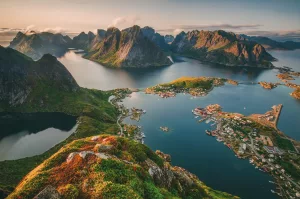Embarking on a journey to explore cultural heritage sites is akin to traveling through time, offering a profound connection to humanity’s collective past. These destinations, steeped in history and tradition, provide a unique lens through which we can understand the diverse tapestry of human culture and civilization. Whether it’s marveling at ancient architectural wonders, immersing oneself in traditional practices, or exploring the artifacts and stories of bygone eras, each site serves as a custodian of the world’s rich cultural legacy.
In this guide, “11 Best Places to Visit for Cultural Heritage,” we delve into an array of remarkable destinations renowned for their historical significance and cultural contributions. From the intricate carvings of ancient temples to the solemnity of historic battlefields, from the vibrant tapestries of traditional festivals to the silent wisdom of age-old ruins, each location offers a unique story and an unforgettable experience.
Whether you’re a history buff, an art enthusiast, a cultural connoisseur, or simply a curious traveler, these 11 destinations promise to ignite your imagination, deepen your understanding, and inspire a sense of wonder and respect for the civilizations that have shaped our world. Join us as we journey through time and space to uncover the best places to visit for an enriching cultural heritage experience.
1. Petra, Jordan

Located in the desert of southern Jordan, Petra is a UNESCO World Heritage site renowned for its rock-cut architecture and ancient culture. The most famous structure in Petra is the Treasury, carved into the pink sandstone cliffs. Visitors can explore the intricate tombs, temples, and caves that make up this fascinating archaeological site. The city dates back to around 300 BC and was the capital of the Nabatean Kingdom. One of the most iconic images of Petra is the Siq, a narrow canyon that leads to the Treasury, creating a dramatic entrance. The site’s remote location adds to its mystical allure, with the journey through the desert enhancing the sense of discovery for visitors.
2. Machu Picchu, Peru

Situated high in the Andes Mountains, Machu Picchu is a 15th-century Inca citadel known for its unique blend of architecture and natural beauty. The site offers stunning views of the surrounding mountains and valleys, making it a must-visit for anyone interested in ancient civilizations. Machu Picchu was built by the Inca emperor Pachacuti and is believed to have been a royal estate or sacred religious site. Its strategic location on a mountain ridge showcases the advanced engineering skills of the Inca civilization. The Intihuatana stone, a ritual stone associated with the sun, is just one of the mysterious and symbolic features that captivate visitors. The journey to Machu Picchu often involves a hike along the famous Inca Trail, adding a sense of adventure and excitement to the experience.
3. Angkor Wat, Cambodia

As the largest religious monument in the world, Angkor Wat is a symbol of Cambodia’s rich cultural heritage. Built in the 12th century, this expansive temple complex features intricately carved sandstone walls and stunning bas-reliefs depicting Hindu epics. Angkor Wat was originally dedicated to the Hindu god Vishnu but later transformed into a Buddhist temple. The site covers a vast area, with intricate architectural details and extensive galleries that display incredible craftsmanship. Visiting Angkor Wat at sunrise or sunset offers a magical experience as the sunlight casts a golden hue over the ancient structures, creating a mesmerizing atmosphere. Exploring the smaller temples and hidden corners of the site reveals the depth of Khmer art and architecture.
4. Jerusalem, Israel

Jerusalem is a holy city for three major religions – Judaism, Christianity, and Islam. The Old City is a UNESCO World Heritage site with significant historical and religious sites, including the Western Wall, Church of the Holy Sepulchre, and Dome of the Rock. The city’s rich history is evident in its diverse architecture, from ancient ruins to medieval structures. Walking through the narrow streets of the Old City allows visitors to experience the blend of traditions and cultures that have shaped Jerusalem over centuries. The Western Wall, also known as the Wailing Wall, is a place of prayer and pilgrimage for Jews, while the Church of the Holy Sepulchre is believed to encompass the sites of Jesus’ crucifixion and resurrection.
5. Kyoto, Japan

Known for its traditional tea houses, temples, and gardens, Kyoto is a cultural treasure trove in Japan. Visitors can experience the serene beauty of places like Kinkaku-ji (Golden Pavilion) and Fushimi Inari Taisha Shrine, which showcase Japan’s rich heritage. Kyoto was once the capital of Japan and served as the center of culture and tradition. The city’s historic districts, such as Gion and Higashiyama, transport visitors back in time with their preserved wooden machiya houses and traditional ryokan inns. The changing seasons bring a new charm to Kyoto, with cherry blossoms in spring and vibrant foliage in autumn creating a picturesque backdrop for temples and shrines.
6. Rome, Italy

Rome, the capital of Italy, is an open-air museum of ancient ruins, art, and architecture. Visitors can explore iconic landmarks like the Colosseum, Roman Forum, and Vatican City to immerse themselves in the history and culture of this eternal city. Rome’s history spans over two millennia, with layers of civilization visible in its architecture and monuments. The Colosseum, a symbol of ancient Rome, once hosted gladiatorial contests and grand spectacles. The Roman Forum, the center of political and social life in ancient Rome, offers a glimpse into daily activities and monumental structures. Vatican City, an independent city-state within Rome, is home to St. Peter’s Basilica and the Vatican Museums, showcasing some of the world’s most renowned art and artifacts.
7. Cusco, Peru

Once the capital of the Inca Empire, Cusco is a city steeped in history and culture. The Spanish colonial architecture blends harmoniously with Inca stone walls, creating a unique urban landscape that reflects Peru’s diverse heritage. Cusco served as the religious and administrative center of the Inca Empire, with temples and palaces dedicated to Inca deities and rulers. The city’s main square, Plaza de Armas, is surrounded by colonial buildings and the imposing Cathedral of Santo Domingo. Exploring the nearby Sacred Valley and the traditional markets of Pisac and Chinchero provides insight into the indigenous culture and craftsmanship that continue to thrive in the region.
8. Xi’an, China

Xi’an is home to the famous Terracotta Army, a collection of terracotta sculptures depicting the armies of Qin Shi Huang, the first Emperor of China. This archaeological marvel offers a fascinating glimpse into ancient Chinese history and craftsmanship. The Terracotta Army was discovered in the 1970s by local farmers and remains one of the most significant archaeological finds in the world. The thousands of life-sized soldiers, horses, and chariots buried with the emperor represent the military might of the Qin Dynasty. In addition to the Terracotta Army, Xi’an boasts ancient city walls, pagodas, and temples that reflect its role as a historic capital of China.
9. Istanbul, Turkey

Situated at the crossroads of Europe and Asia, Istanbul is a city rich in cultural heritage. From the historic Hagia Sophia and Blue Mosque to the bustling Grand Bazaar, visitors can explore a blend of Byzantine, Ottoman, and modern Turkish influences. Istanbul’s strategic location has made it a melting pot of civilizations over the centuries, with architectural wonders that span different eras. The Hagia Sophia, originally a Byzantine church, later converted into an Ottoman mosque, stands as a symbol of the city’s diverse history. The Blue Mosque, with its intricate tile work and grand domes, is a masterpiece of Ottoman architecture. The Grand Bazaar, one of the world’s oldest and largest covered markets, offers a sensory experience with its vibrant stalls and traditional crafts.
10. Athens, Greece

Considered the cradle of Western civilization, Athens is a treasure trove of ancient ruins and landmarks. The Acropolis, Parthenon, and Ancient Agora are just a few of the must-visit sites that showcase Greece’s architectural and philosophical legacy. Athens was the birthplace of democracy, philosophy, and theater, leaving a lasting impact on Western culture. The Acropolis, a rocky hill towering over the city, houses the iconic Parthenon temple, dedicated to the goddess Athena. The Ancient Agora, once the heart of Athenian political life, features well-preserved ruins and temples. Exploring the National Archaeological Museum and strolling through the charming Plaka neighborhood offer insights into Greece’s rich history and modern-day culture.
11. Luxor, Egypt

Located on the east bank of the Nile River, Luxor is known as the world’s greatest open-air museum. The Valley of the Kings, Karnak Temple, and Luxor Temple are just a few of the ancient sites that offer a glimpse into Egypt’s rich pharaonic history. Luxor served as the capital of ancient Egypt during the New Kingdom period, with temples and tombs dedicated to the pharaohs and gods. The Valley of the Kings is the final resting place of many pharaohs, including Tutankhamun, with elaborately decorated tombs that reveal the beliefs and rituals of the afterlife. Karnak Temple, a vast complex of temples and pylons, showcases the grandeur of Egyptian architecture and religious practices. The annual Opet Festival reenacts the ancient procession between Karnak and Luxor Temples, highlighting the city’s cultural and spiritual significance.




